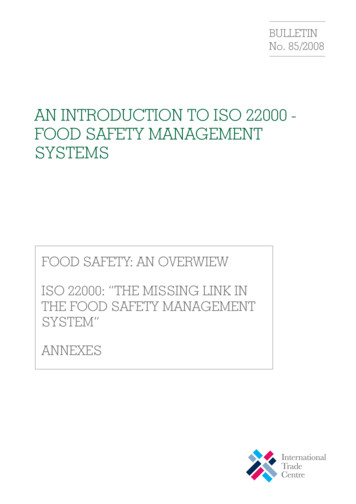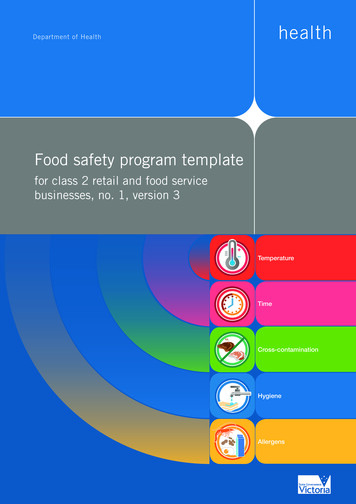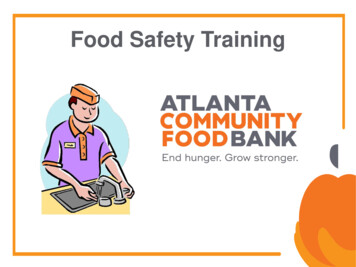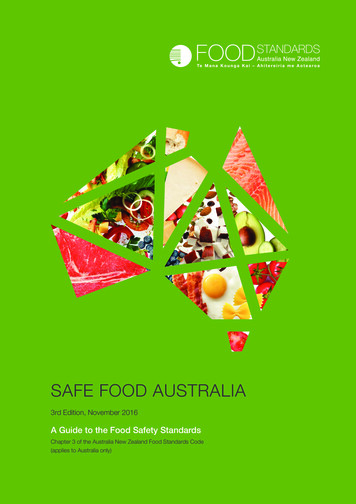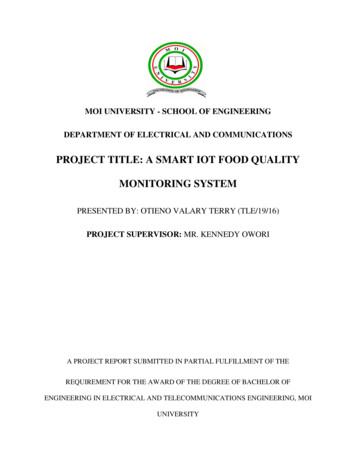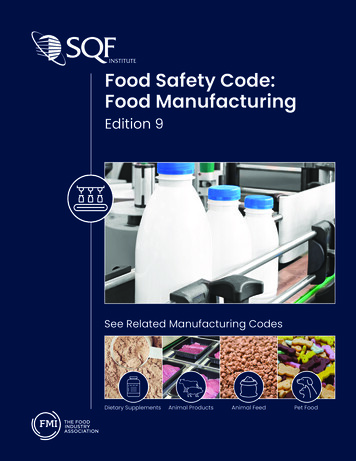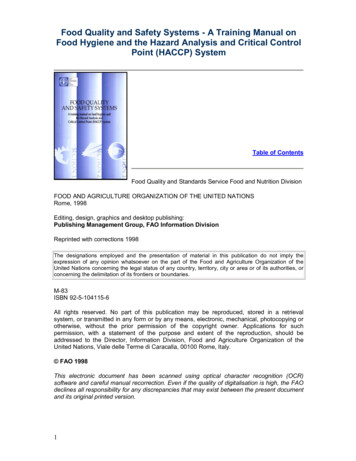
Transcription
Food Quality and Safety Systems - A Training Manual onFood Hygiene and the Hazard Analysis and Critical ControlPoint (HACCP) SystemTable of ContentsFood Quality and Standards Service Food and Nutrition DivisionFOOD AND AGRICULTURE ORGANIZATION OF THE UNITED NATIONSRome, 1998Editing, design, graphics and desktop publishing:Publishing Management Group, FAO Information DivisionReprinted with corrections 1998The designations employed and the presentation of material in this publication do not imply theexpression of any opinion whatsoever on the part of the Food and Agriculture Organization of theUnited Nations concerning the legal status of any country, territory, city or area or of its authorities, orconcerning the delimitation of its frontiers or boundaries.M-83ISBN 92-5-104115-6All rights reserved. No part of this publication may be reproduced, stored in a retrievalsystem, or transmitted in any form or by any means, electronic, mechanical, photocopying orotherwise, without the prior permission of the copyright owner. Applications for suchpermission, with a statement of the purpose and extent of the reproduction, should beaddressed to the Director, Information Division, Food and Agriculture Organization of theUnited Nations, Viale delle Terme di Caracalla, 00100 Rome, Italy. FAO 1998This electronic document has been scanned using optical character recognition (OCR)software and careful manual recorrection. Even if the quality of digitalisation is high, the FAOdeclines all responsibility for any discrepancies that may exist between the present documentand its original printed version.1
Table of ContentsForewordPrefaceSection 1 - PRINCIPLES AND METHODS OF TRAININGIntroductionModule 1 - Principles of effective communication - "Getting the message across"Module 2 - Effective oral communicationModule 3 - Why train? The trainer's role and responsibilityModule 4 - Methods of training - The right methodModule 5 - The art of questioningModule 6 - Types of training aids - How to make and use themModule 7 - Planning and delivering a presentationModule 8 - Evaluating trainingModule 9 - Testing trainee trainers - Individual presentationsModule 10 - Organizing and managing a training courseSection 2 - RECOMMENDED INTERNATIONAL CODE OF PRACTICE - GENERALPRINCIPLES OF FOOD HYGIENEIntroductionModule 1 - The Codex Alimentarius CommissionModule 2 - The Codex General Principles of Food HygieneModule 3 - Primary productionModule 4 - Establishment: design and facilitiesModule 5 - Control of operationModule 6 - Establishment: maintenance and sanitationModule 7 - Establishment: personal hygieneModule 8 - TransportationModule 9 - Product information and consumer awarenessModule 10 - TrainingSection 3 - THE HAZARD ANALYSIS AND CRITICAL CONTROL POINT (HACCP)SYSTEMIntroductionModule 1 - History and background of the HACCP systemModule 2 - The Codex guidelines for the application of the HACCP systemModule 3 - Assemble the HACCP team - Task 1Module 4 - Describe product and identify intended use - Tasks 2 and 3Module 5 - Construct flow diagram and on-site confirmation of flow diagram - Tasks 4 and 5Module 6 - List all potential hazards associated with each step, conduct a hazard analysisand consider any measures to control identified hazards - Task 6/Principle 1Module 7 - Determine critical control points - Task 7/Principle 2Module 8 - Establish critical limits for each critical control point - Task 8/Principle 3Module 9 - Establish a monitoring system for each critical control point - Task 9/Principle 4Module 10 - Establish corrective actions - Task 10/Principle 5Module 11 - Establish verification procedures - Task 11/Principle 6Module 12 - Establish documentation and record keeping - Task 12/Principle 72
Annex 1 - Blank HACCP formsAnnex 2 - The application of risk analysis to food safety control programmesForewordThe Food and Agriculture Organization of the United Nations (FAO) is the principalspecialized UN agency dealing with all aspects of food quality and safety throughout each ofthe stages of food production, storage, transportation, processing and marketing. Work in thisarea is carried out by the Food Quality and Standards Service of the FAO Food and NutritionDivision. Activities include providing policy advice and executing food quality control andsafety development projects, including the development of food standards and technicalregulations; food quality and safety assurance programmes for the food industry; establishingnational export food certification programmes; monitoring programmes for food contaminants;and conducting regional and national seminars and workshops on food control issues.One important element of FAO's work is building the capacity of food control personnel,including government authorities and food industry personnel carrying out food quality andsafety assurance programmes. Such programmes should include specific food risk controlprocedures such as the Hazard Analysis and Critical Control Point (HACCP) system.In December 1994, FAO held an expert consultation on HACCP principles in food control.The experts recommended that FAO should continue to emphasize high-quality and effectivefood industry and government HACCP training, based on the development of a corecurriculum and the harmonized text and guidelines of the Codex Alimentarius Commission.In February 1995, an ad hoc working group was formed and a core curriculum was developedfor a training of trainers programme. The core curriculum recognizes the importance of thebasic quality and safety controls included in the Codex General Principles of Food Hygieneand good manufacturing practices as embodied in the Codex Codes of Practice as a basis foreffective implementation of the HACCP system. The training programme has been tested inThailand, Brazil, Viet Nam and Slovakia. This training manual on food quality and safetysystems is a direct result of that work.The manual is structured to provide essential information in a standardized, logical andsystematic manner while adhering to effective teaching and learning strategies. It iscomposed of three sections. Section 1 reviews principles and methods of training; Section 2introduces and elucidates the Codex Alimentarius General Principles of Food Hygiene; andSection 3 explains the HACCP system and its implementation. Each section is made up ofspecific training modules which can be combined and customized to meet the specific needsof the students.FAO has prepared this manual in an effort to harmonize the approach to training in theHACCP system based on the already harmonized texts and guidelines of the CodexAlimentarius Commission. It is clear that HACCP systems can only be effective when they area part of a broader food quality and safety programme based on the General Principles ofFood Hygiene and good manufacturing practices. Consequently, these aspects of quality andsafety controls are incorporated in the training materials. We invite readers' comments andsuggestions for improving this manual as part of our continuing effort to provide high-qualityadvice and reference materials to FAO member countries.John R. LupienDirectorFAO Food and Nutrition Division3
PrefaceAll countries need adequate food control programmes to ensure that national food suppliesare safe, of good quality and available in adequate amounts at affordable prices to ensure anacceptable nutritional and health status for all population groups. Food control includes allactivities carried out to ensure the quality, safety and honest presentation of the food at allstages from primary production, through processing and storage, to marketing andconsumption. The term has been used to describe a total national effort involving anintegrated approach between government and all segments and sectors of the food industry.Food control is linked to improvement in the health of the population, potential for a country'seconomic development and reduction of spoilage and food losses.The Codex Alimentarius General Principles of Food Hygiene lay a firm foundation forensuring effective food control and food hygiene. The General Principles of Food Hygienefollow the food chain from primary production through to the consumer, highlighting the keyhygiene controls at each stage. A Hazard Analysis and Critical Control Point (HACCP)approach is recommended wherever possible to enhance food safety. The HACCP approachis internationally recognized as being effective in ensuring the safety and suitability of food forhuman consumption and in international trade.Recognizing the importance of HACCP to food control, the twentieth session of the CodexAlimentarius Commission, held in Geneva, Switzerland from 28 June to 7 July 1993, adoptedGuidelines for the application of the Hazard Analysis Critical Control Point (HACCP) system(ALINORM 93/13A, Appendix II). The revised version of the Recommended InternationalCode of Practice - General Principles of Food Hygiene [CAC/RCP 1-1969, Rev. 3 (1997)],adopted during the twenty-second session of the Codex Alimentarius Commission, held inGeneva from 23 to 28 June 1997, incorporates the Hazard Analysis and Critical Control Point(HACCP) system and guidelines for its application as Annex.The HACCP system, as it applies to food safety management, uses the approach ofcontrolling critical points in food handling to prevent food safety problems. Besides enhancingfood safety, other benefits of applying HACCP include effective use of resources and timelyresponse to food safety problems. In addition, the application of the HACCP system canresult in more focused risk management by food control regulatory authorities and canpromote international trade by increasing buyer confidence in food safety.The HACCP system identities specific hazards and control measures to ensure the safety offood. An HACCP plan is specific to the particular food and processing application. TheHACCP system is capable of accommodating change, such as advances in equipmentdesign, new information concerning health hazards or risks, new processing procedures ortechnological developments.The successful application of HACCP requires the full commitment and involvement ofmanagement and the workforce. It also requires a team approach. The application of theHACCP system is compatible with the implementation of quality management systems, suchas the ISO 9000 series, and HACCP is the system of choice for the management of foodsafety within such systems.HACCP and tradeSignificant implications for the Codex Alimentarius Commission arise from the Final Act of theUruguay Round of the General Agreement on Tariffs and Trade (GATT): the Agreement onthe Application of Sanitary and Phytosanitary Measures (SPS Agreement) and the Agreementon Technical Barriers to Trade (TBT Agreement). Codex standards, guidelines and other4
recommendations have become the specifically identified baseline for consumer protectionunder the SPS Agreement. In this environment they take on unprecedented importance withrespect to consumer protection and international food trade. As a result, the work of theCodex Alimentarius Commission (including the Hazard Analysis and Critical Control Point[HACCP] system and guidelines for its application) has become the reference for internationalfood safety requirements.While the improved level of food safety associated with the implementation of HACCP andthe leading role taken by the food industry are recognized, the application of HACCP as apublic policy requires definition of the role of government in the utilization of the HACCPprocess and risk analysis. Individual countries need to address the issue of HACCPimplementation so that their food export industry can meet the requirement recently adoptedby some importing countries related to HACCP application to food products. The mandatoryrequirement to use HACCP and any subsequent barriers or other constraints to trade,particularly for developing countries, need to be considered and identified. The appropriateapplication of HACCP to different segments of the food chain and the impact of thisapplication on small and medium-sized food industries also needs to be addressed.Recent FAO activitiesRecognizing the importance of HACCP in food control and the necessity and importance ofimproving the safety of food in international trade, and to address the issues identified above,FAO convened an expert technical meeting in Vancouver, Canada from 12 to 16 December1994 to discuss the use of HACCP principles in food control.The expert technical meeting noted that training in the application and implementation of theHACCP system was of utmost importance and recommended that FAO consider assumingthe leadership role in conducting high-quality and effective industry and government HACCPtraining. In their report, the experts also recommended that FAO establish an inventory ofavailable HACCP models and training reference material and prepare a core curriculum forpractical HACCP training courses. It was recommended that the training be focused ondeveloping skills and methods necessary for training government and industryrepresentatives in the requirements of the Codex General Principles of Food Hygiene and theprinciples and steps in implementation of HACCP. Further, the core curriculum should bemodifiable to reflect cultural sensitivities and to address infrastructural problems in individualcountries.As follow-up to the training recommendations of the expert technical meeting, FAO conveneda temporary technical working group which met in Rome from 13 to 17 February 1995 to plana training of trainers course in HACCP for developing countries. The temporary technicalworking group consisted of representatives from the Centre of Export Inspection andCertification of Agricultural Products, Thailand Department of Agriculture; the Thai FoodIndustry; and international experts in food sanitation and hygiene, HACCP and trainingtechniques. The working group prepared a tentative agenda for a course on training oftrainers in the application of HACCP to be held in Thailand.The meeting participants agreed that the objectives of the training should be to promote acommon approach to the application of HACCP based on the Codex guidelines and to instiltrainers where possible with sufficient skills in the theory and application of HACCP to trainothers. The training should establish agreed terminology and basic understanding of HACCPprinciples and impart to the trainees those skills necessary for the application of HACCP tofood safety in both the public and private sectors.Two pilot training courses were carried out in Cha Am, Thailand (31 July to 11 August 1995)and Sao Paulo/Brazil (12 to 23 August 1996). It was concluded that the course formatachieved its objective of imparting a thorough understanding of the technical information andits application to the participants. Participants completing the course demonstrated practical5
knowledge of the General Principles of Food Hygiene and the application of the HACCPsystem and the ability to train other people.The FAO approach to the HACCP systemThere is a tremendous demand for training in the HACCP system and the development andassembly of reference materials to support this training, particularly in developing countries. Itis a matter of urgency to provide the necessary clarification with regard to the application ofthe HACCP system.The objective of the FAO HACCP training programme is to promote good manufacturingpractices (GMPs) and the HACCP system through understanding and application of theCodex General Principles of Food Hygiene, including the Codex guidelines for the applicationof the HACCP system and other Codex codes of hygienic practice. FAO is working toenhance the role of science and risk analysis in the development of the HACCP system andto create a framework for determining equivalence of food safety control programmes for aharmonized approach to the application of HACCP.The FAO training programme harmonizes the approach to GMPs and the application of theHACCP system and aims to provide an effective mechanism for delivering the appropriatecore curriculum and knowledge to selected segments and sectors of the food industry,individuals involved to varying degrees in the preparation, monitoring, administration andverification of HACCP plans and food control regulators. Included in the FAO trainingprogramme is emphasis on training the trainers who are in a position to train others and toapply the knowledge gained and hence to contribute to self-reliance, particularly in developingcountries.To accomplish these objectives, FAO has embarked on a plan to develop furthercollaboration and partnerships with regional and national counterparts, where possible withother international organizations and with the food industry to review the needs of thedeveloping countries regarding their HACCP system implementation plans and to establishworkable strategies.The training packageTraining is not an objective in itself but is linked to improvement in a country's public healthand economic development. It is in this context, and recognizing the need to standardizeGMPs and HACCP training, that FAO has prepared the training package on the CodexAlimentarius General Principles of Food Hygiene and the application of the HACCP system.In order to harmonize or standardize the approach to training/Sections 2 and 3 of the trainingpackage are formatted around the Codex Recommended International Code of Practice General Principles of Food Hygiene and the Hazard Analysis and Critical Control Point(HACCP) system and guidelines for its application. The training manual consists of threesections: Section 1: Principles and methods of training Section 2: Recommended International Code of Practice - General Principles of FoodHygiene Section 3: The Hazard Analysis and Critical Control Point (HACCP) systemEach section is composed of training modules; this format allows for the training material tobe combined and customized as appropriate to the specific trainees. Sections and/or modules6
can be selected by the instructor as appropriate to the level of knowledge, experience andspecific responsibilities of the trainees in a given course.An introductory section for each module outlines the objective, suggested methods ofinstruction, teaching aids and/or references, lesson content, presentation suggestions orexercises, anticipated time frame for instruction and anticipated learning outcome for thetrainees.The FAO training programme is not static; because of its modular approach it is sufficientlyflexible to adapt to the evolution of food safety programmes and requirements. Modules canbe added, deleted or amended as appropriate to remain current and to provide theappropriate training materials.Content and material have been selected and structured to ensure that the training packageprovides essential information in a standardized, logical and systematic manner whileadhering to effective teaching and learning strategies. The package is intended to standardizethe training approach and to reduce the research and preparation time normally required byan instructor offering comprehensive courses of this nature. It should be noted, however, thatthe contribution of the individual instructor is essential to the success of the training. Theinstructor may add material as appropriate to the specific training. The instructor's personalexperiences, elaboration and discussion of key points, anecdotes, review and questioningopportunities and involvement of the students are the means by which the material will becommunicated, absorbed, enjoyed and understood.Section 1 - PRINCIPLES AND METHODS OF TRAININGIntroductionModule 1 - Principles of effective communication - "Getting the message across"Module 2 - Effective oral communicationModule 3 - Why train? The trainer's role and responsibilityModule 4 - Methods of training - The right methodModule 5 - The art of questioningModule 6 - Types of training aids - How to make and use themModule 7 - Planning and delivering a presentationModule 8 - Evaluating trainingModule 9 - Testing trainee trainers - Individual presentationsModule 10 - Organizing and managing a training courseIntroductionThe objective of Section 1 is to address the basic elements necessary for the effectivepreparation, implementation and evaluation of training, with the aim of that training being "toget the message across".To achieve that objective, the modules that follow are intended to provide guidance to trainersin the skills of conveying their message successfully and transferring related information.Training is essentially the instructing of others in information new to them and its application.It may, and often does, involve the teaching of new skills, methods and procedures.7
Very few people are born trainers, and most of those who wish to be trainers require training.Even those few who are born trainers benefit from training, and their effectiveness isenhanced as a result.The most important element in a training situation is the trainer. The trainer who isenthusiastic, energetic and genuinely interested in both the subject and getting his or hermessage across will evoke the greatest response from the trainees. The trainer who lacksinterest in training, who has little or no enthusiasm for the subject of the training and whomerely goes through the motions of training is a failure. Such a trainer wastes not only his orher own time but also that of the trainees. The inept trainer is quickly identified by thetrainees, who react with inattention, lassitude, undisciplined behaviour and absence fromtraining sessions.Successful training - that which produces the desired result - lies almost entirely in the handsof the trainer. In the trainer's hands lies the heavy responsibility for ensuring that the traineesachieve the maximum possible from the training.A measure of the success of training is the relationship that develops between trainer andtrainees. In a sound, productive training situation there is mutual respect and trust betweenthem, with the trainer taking care to ensure that even the weakest trainee performs to thehighest possible level, and the trainees feeling a desire within themselves to achieve. In thissituation the trainer is the motivator and the trainees are the motivated.It is intended that the modules that follow will be of assistance to those wishing to train andthose already training.The modules have been arranged as follows: Module 1: Principles of effective communication - "Getting the message across" Module 2: Effective oral communication Module 3: Why train? The trainer's role and responsibility Module 4: Methods of training - The right method Module 5: The art of questioning Module 6: Types of training aids - How to make and use them Module 7: Planning and delivering a presentation Module 8: Evaluating training Module 9: Testing trainee trainers - Individual presentations Module 10: Organizing and managing a training courseThe above arrangement is systematic. Modules 1 and 2 deal with training theory. Module 3 istransitional in that it links the theory with the applied training methods covered by Modules 4to 7. Modules 8 and 9 cover the important aspect of measuring and assessing theeffectiveness of the training and the trainer. Module 10 is related to the management oftraining or, in other words, creating a favourable environment in which to train.It is important that all members of a training team be familiar with the principles espoused inthe training modules. This ensures that every presentation in a training course embodies theprinciples and in itself is a demonstration of the application of those principles: the traineesare not only told how to train, but see how it should be done.It is stressed that the modules are not intended to constitute a textbook on training.Essentially, their contents are intended as memory joggers for those trained to train others.For this reason, and depending on the nature of the subject, some material is presented inpoint form while other material is covered by full text.8
The training segment of this programme provides only the supports of training theory andpractice. This places a heavier than normal responsibility on the trainer, who must in the spanof ten hours make the deepest possible impression on the trainees if they are to be turned outas proficient trainers. This means not only that the trainer must be familiar with and skilled inpresenting the training information and related methods, but that he or she must be at leastfamiliar with many other aspects of training not covered by the modules, for example,motivation theory, the art of public speaking, conducting discussions, course planning, writtencommunication and so on. A knowledge of these subjects enables the trainer to weaveappropriate strands from them into the presentations of the modules, thus broadening thetrainees' experience. There are many excellent texts on training as well as training manualsproduced by training units in government ministries and departments, private companies andother organizations. Dedicated trainers make it an essential part of their continuing educationas professionals to locate such publications in libraries or elsewhere, and by so doing keepabreast of theory and practice.Module 1 - Principles of effective communication - "Getting themessage across"ObjectiveTo familiarize the participants with the elementary principles of successful oral communicationof information and to heighten awareness of the factors that interfere with communication andreduce its effectivenessSuggested method of instruction Lecture/discussion with maximum trainee participation through questioning and relating ofpersonal experienceAids Overhead transparencies HandoutsTime frame One hour lecture/discussionContent Effective communication Interference Ways of avoiding interferencePresentation suggestionsThe foregoing module is easily adapted to discussion. The trainer should attempt to elicit fromthe trainees their experiences with transmission, interference and ways of avoidinginterference, which are well within the purview of trainee experience.Trainees should be asked to tell the course participants about good communicators and poorcommunicators they have known, describing why they are memorable. The reasons they giveshould be related to the types of interference and ways in which interference was or couldhave been avoided.9
Such a discussion invariably brings out other indirectly related aspects of spokencommunication which provide points of reference when subjects in later modules are beingdealt with.Learning outcomeParticipants should be aware of effective communication principles.EFFECTIVE COMMUNICATIONCommunication specialists compare the way people communicate to the way a radiotransmission takes place. That is to say:Transmitter (Speaker/writer) Message Receiver (Listener/reader)Three types of transmission are identified: Spoken Written Gesture/sometimes referred to as "body language"Transmission is in code: Spoken language Written language GesturesIn spoken language the unit of code is the word, heavily supported by gestures. Somecommunication specialists believe that at least 40 percent of the full meaning of messagestransmitted by speech is conveyed by body language (gestures). In written language the unitsof code are words and symbols (e.g. figures, punctuation). In the remainder of this moduleand the modules that follow reference to communication is to spoken communication only andassumes the transmitter can be seen by the receiver.Successful communication depends on the message being received by the receiver intact andinterpreted by the receiver to have the same meaning as when transmittedINTERFERENCEFrequently the message suffers from interference. That is, something interferes with themessage between its transmission and reception and distorts it. The following are some typesof interference.Weak transmission Speaking too softly Speaking in a flat voice (monotone) without inflection Not speaking in a direct line with the receiver Insufficient volume of transmission to prevail over competing transmissions and localizednoise (static)Garbled transmissionThe transmitter (speaker) often scrambles the contents of the message so that the facts itcontains are not in logical order and often appear unrelated.10
Wrong languageThe transmitter may use words, terms and expressions unknown to the receiver.Pitching message at the wrong levelThe speaker may transmit information in a context beyond the experience of the receiver (thismay involve the use of wrong language). This is sometimes called "transmitting or talking overthe receiver's head". Examples are teaching food control procedures or HACCP to peoplewho have no experience in food safety or food processing, or transmitting detailed andprofound scientific messages to a receiver without a scientific background.Receiver not receiving Receiver turned off (gone to sleep!) Tuned into another transmitter Transmission too weak Strength of receiver diminished (lack of interest - boredom) Receiver distracted by a competing focus of interest (an attractive person walks by) Receiver fatiguedCompeting transmissionsThe receiver may be unable to select between transmissions (too many people talking atonce).Overloading the messageThe receiver does not possess the capacity to retain all of the information contained in themessage. This frequently leads to receiver confusion/fatigue and anxiety.WAYS OF AVOIDING INTERFERENCE Speak up and out Speak slowly and deliberately Use language that the receiver understands Do not talk over the receiver's head Ensure you have the attention of the receiver Only transmit your message in suitable surroundings where there is no, or little, competition Make the message succinct (as few words as possible
HACCP system is compatible with the implementation of quality management systems, such as the ISO 9000 series, and HACCP is the system of choice for the management of food safety within such systems. HACCP and trade Significant implications for the Codex Alimentarius Commission arise from the Final Act of the

